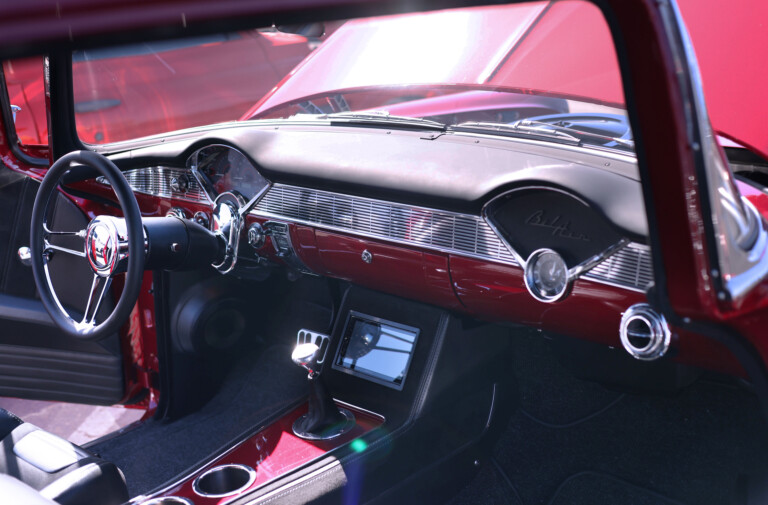Words and Photos By Richard Holdener
Why on earth would anyone want to replace the factory rocker arms on an LS application? Aren’t they already roller rockers? Aren’t they already lightweight? Haven’t they been proven effective on countless thousands of high-powered LS applications? The answer to all of these questions is yes, including the first one. Confused? Don’t be, as the factory roller rockers employed on every LS application offer a great many positive qualities, but rest assured, there is additional power to be had with the right rocker upgrade.
As with any modification, replacing the factory rockers with roller rockers might take additional hardware, like pushrods or certainly valve springs, but when you go looking for power, leave no stone unturned. To illustrate the gains offered by upgrading the factory rockers, we ran a back-to-back test using the stock rockers and a set of 1.72-ratio, aluminum roller rockers from COMP Cams. Before getting to the test results, let’s take a look at the test motor.
Rather than run the test one of the many stock LS applications, we decided to compare the rockers on a more dedicated build up. Starting with an aluminum 5.7L block, we proceeded to stroke and poke the LS6 out to 383c.i. The boys at L&R Automotive were responsible for the machining to accept the Speedmaster 4.0-inch stroker crank, JE forged pistons, and K1 connecting rods. Unlike stock pistons, the JE forgings featured valve reliefs to allow use of high-lift (long duration) cam profiles. Minor machining on the bottom of the cylinder bore (for rod bolt clearance) was necessary with this stroker assembly. In addition to the new rings and bearings, Fel Pro also came through with a new oil pump, timing chain, and MLS head gaskets. Use of the 4.00-inch stroker crank meant it was necessary to shim and clearance the factory windage tray using washers and a small mallet.
With a stout short block at the ready, it was time to make some power. First on the To Do list was the proper camshaft. With power and drivability in mind, we selected an off-the-shelf grind from COMP Cams. Though we were running cathedral-port heads, we made our selection from the many rec-port offerings from COMP. The 281LRR HR13 (pt# 54-461-11) featured a healthy .617/.624 lift split, a 231/247-degree duration split, and 113-degree lsa. COMP Cams also supplied a new set of hydraulic roller lifters (pt# 850-16), a set of Magnum pushrods (7.45 inches in length), and the required aluminum roller rockers for the test.
The combination of displacement and our power producers (heads, cam, and intake) combined to

Dialing in the air/fuel and timing curves on the aluminum stroker for our rocker test was this FAST XFI/XIM management system. Consistent air/fuel and timing curves are critical for accurate testing.
produce peak power numbers near 6,500 rpm. The high-lift cam allowed the engine to take full advantage of the flow offered by ported heads, while the duration figures made the sucker rev.
Working with the COMP cam was a set of 243 LS6 cylinder heads. To maximize the flow rate of the factory castings, the heads were shipped off to Total Engine Airflow (TEA) for their Stage 2 porting. The procedure included CNC porting of the intake, exhaust, and combustion chamber, revised valve sizing and a new spring package. The CNC procedure resulted in intake port volumes of 225cc. When combined with the new 2.04-inch stainless steel valves and the CNC chamber work, the results were peak intake flow numbers of 328 cfm at just .600 lift. The exhaust flow was equally impressive through the new 1.57-inch valves, at 270 cfm. More than just peak numbers, the TEA Stage 2 package significantly improved the flow rate of the stock castings through the entire lift range, which is what really makes power.
The final touch on the TEA LS6 heads was a dual valve-spring package combined with titanium retainers. The springs offered enough seat and open pressure, coil-bind, and retainer-to-seal clearance to run cams with as much as .650 lift (perfect for our cam choice). The springs were also sufficient for use with the 1.72-ratio, aluminum roller rockers.
The final power producer employed on the aluminum stroker test motor was a 10-mm, LSXRT composite intake manifold from FAST. To maximize flow to the motor, the intake was teamed with one of FAST’s massive 102mm Big-Mouth throttle bodies. The intake combo was fed by a set of billet fuel rails and 42-pound injectors, all from FAST. Finishing touches on the LS6 stroker included the factory coil packs, a FAST XFI/XIM management system, and a set of 1 7/8-inch stainless steel headers from American Racing (with 18-inch collector extensions).
Prior to start up, the pan was filled with 5W-30 Lucas Oil, and the motor was spun using the starter until oil pressure was visible on the gauge. Once started, the motor was treated to a pair of computer-controlled break-in cycles before running our rocker test. Equipped with the stock rockers, the 383 stroke produced repeatable runs of 578 hp at 6,500 rpm and 542 lb-ft of torque at 4,700 rpm.
After running the stock rockers, it was time to upgrade to the COMP units. For rockers, we chose a set of bolt-down, COMP Ultra-Gold Arc Series rockers (pt# 19024-16). The rockers offered ease of installation (simple bolt-down replacement), a 1.72:1 rocker ratio to slightly increase lift (stock LS was 1.7), and extra strong, CNC-extruded rocker bodies that featured billet trunnions with captured needle bearings. Toss in a roller tip to replace the friction-robbing, factory slider tip and you have the makings of a serous rocker upgrade. The rocker swap was a simple bolt-down affair using the supplied rocker stands to replace the factory unit.

LS Stroker Rocker Test-Stock vs COMP Roller
The results of the roller rocker test were interesting, as the roller rockers offered no power gains up to 5,300 rpm. From 5,300 rpm to 6,600 rpm, the gains were substantial, as the change in ratio, reduced friction, and consistent ratio improved the power output by as much as 12 hp. For high-lift cams, the roller rockers will also increase the longevity of valve tips and guides; just make sure you have sufficient valve spring pressure to work with the added weight of the roller rockers.
Once installed, we ran the 383 stroker and were immediately rewarded with additional power. The roller rocker upgrade increased the peak power output to 588 hp at 6,400 rpm, but peak torque checked in at 541 lb-ft at 4,800 rpm. The rockers offered additional power only above 5,300 rpm, with no change in the curve below that porting. It should be pointed out that the extra weight of the rockers will require sufficient spring pressure, but our TEA heads were already equipped for the test. If you are looking for more power, you might try getting off those stock rockers and going roller!
Sources: American Racing Headers, americanracingheaders.com; COMP Cams, compcams.com; FAST, fuelairspark.com; JE Pistons, jepistons.com; K1, k1technologies.com; L&R Automotive, lnrengine.com; Speedmaster, speedmaster79.com; Total Engine Airflow, totalengineairflow.com; Total Seal Rings, totalseal.com


















